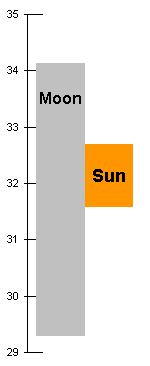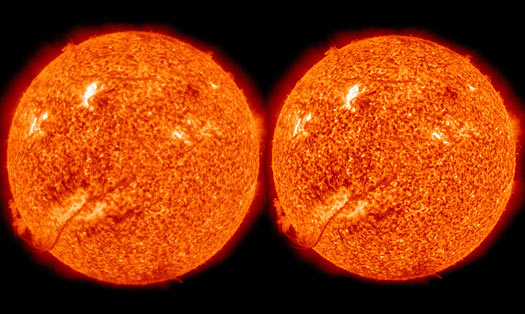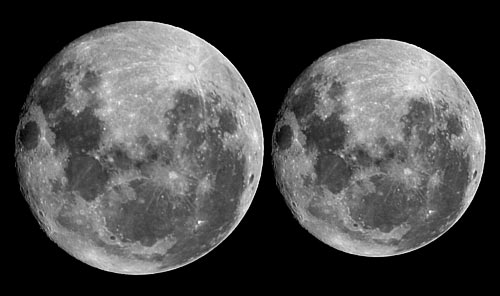A reader writes:
The Oatmeal recommends sites get more traffic and Facebook likes by writing an epic love story involving cage-fighting nuns and tanks, or if that is not possible, explaining why the sun and the moon appear to be the same size in the sky.
Both of these seem right up your alley, but frankly I for some reason find the second one more interesting. Why ARE the sun and moon the same size? Is it just a bizarre coincidence, or is there some astronomical orbit reason for it?
Lucas
I'm afraid it is indeed just a fluke. Which, furthermore, starts to look less amazing when you discover that the sun and moon don't actually have a particularly spooky similarity in size.
I remember reading some flaky book when I was a kid, possibly some von Däniken claptrap or other, that made much of the extraordinarily precise apparent-size match between the 0.55-Earth-diameter moon and the 109-Earth-diameters sun. Surely this cannot be mere coincidence, hence ancient astronauts and Nazi moon bases and the various Stargate series are all documentaries et cetera.
Unfortunately for these otherwise-very-plausible speculations, the sun and moon are not actually the same size in the sky. They can be, but they usually aren't.
The earth's orbit around the sun is not perfectly circular, but it's close. On average it's one astronomical unit (oddly enough), but we're closest, 0.983 AU, in early January, and furthest, 1.017 AU, in early July. The actual sun stays the same size, so from our point of view it ranges from 31.6 to 32.7 minutes of arc.
For visual learners, that's about this much of a range:
(I made this from this NASA picture depicting a gigantic magnetic filament erupting from the surface of the sun. The same filament would not, of course, be there in both January and July.)
The moon's orbit around us is more eccentric than the earth's orbit around the sun, so the moon changes in apparent size much more dramatically than the sun does. It ranges from 29.3 to 34.1 arc-minutes or, to the same scale as the above sun picture...
...this much.
(I took that moon picture myself. Residents of the northern hemisphere are invited to stand on their heads to make it look more familiar.)
(UPDATE: I forgot to mention the moon illusion when I first put this post up. Yes, the moon, and the sun too for that matter, seems bigger when it's near the horizon. No, it actually isn't. If anything, it's smaller!)

Here's the two ranges compared.
The only time when ordinary people really compare the size of the sun and moon is, of course, when there's a total solar eclipse. Then it really does look as if the moon neatly covers the entire sun, helpfully giving us a nice view of the corona, which is normally washed out by the much greater brightness of the body of the sun. (You can actually view the corona from the surface of the earth at other times, but you need special equipment to block out sky-glare.)
At this point, you may be wondering whether the roughly-month-long lunar size cycle and the year-long solar size cycle can coincide with an eclipse in such a way as to put a minimum-size moon in front of a maximum-size sun (well, any size of sun, really, there's not that much difference), so that the moon fails to completely obscure the sun.
Yes, it can; it's called an annular eclipse, and there's one coming shortly, though I won't be able to see it from here in Australia.
Here is a lot more information about all of this.
Psycho Science is a regular feature here. Ask me your science questions, and I'll answer them. Probably.
And then commenters will, I hope, correct at least the most obvious flaws in my answer.


2 May 2012 at 10:58 pm
Unlike depicted in some movies, a solar eclipse is only visible from a small area on Earth. Move 200km north or south and you'll get a partial eclipse. Move 2000km north or south and the moon will just graze the disk of the sun.
There are a few movies on YouTube showing the shadow of the moon as captured by meteorological satellites.
There's also an eclipse coming in November, so those in Cairns will see a total eclipse shortly after sunrise, I'll see a partial eclipse, and Dan should see the moon grazing the disk of the sun.
3 May 2012 at 12:50 am
And as a further coincidence... Both the sun and the moon are exactly the same size as a fingernail! (For suitable values of sun-size, moon-size and fingernail.)
3 May 2012 at 2:03 am
And to complete the "it is indeed just a fluke" angle... The Moon is also slowly drifting away from the Earth (IIRC about 40mm/year). As a result, there was a time in the distant past when no non-partial eclipses were annular, and there'll be a time in the distant future when all non-partial eclipses will be annular.
3 May 2012 at 11:29 am
Phil Plait has been discussing supermoons too:
http://blogs.discovermagazine.com/badastronomy/2012/05/02/the-supermoon-stuff-again/
If nothing else, you can compare Dan's upside down moon pictures to those of a Greek amateur astronomer.
3 May 2012 at 10:51 pm
It's a little known fact that if you stare at the sun long enough it will disappear completely all on its own. Of course, so does everything else.
4 May 2012 at 2:39 pm
I would "like" this on facebook, but there's no button... oh the terrible, crushing irony!
6 May 2012 at 4:06 pm
You have a point.
My posts now have a Like button at the end. It probably even works.
EDIT: I've switched to a floating button-bar thing instead of the little button at the end. It seems to behave itself well in different browsers and resolutions; tell me if it screws anything up for you.